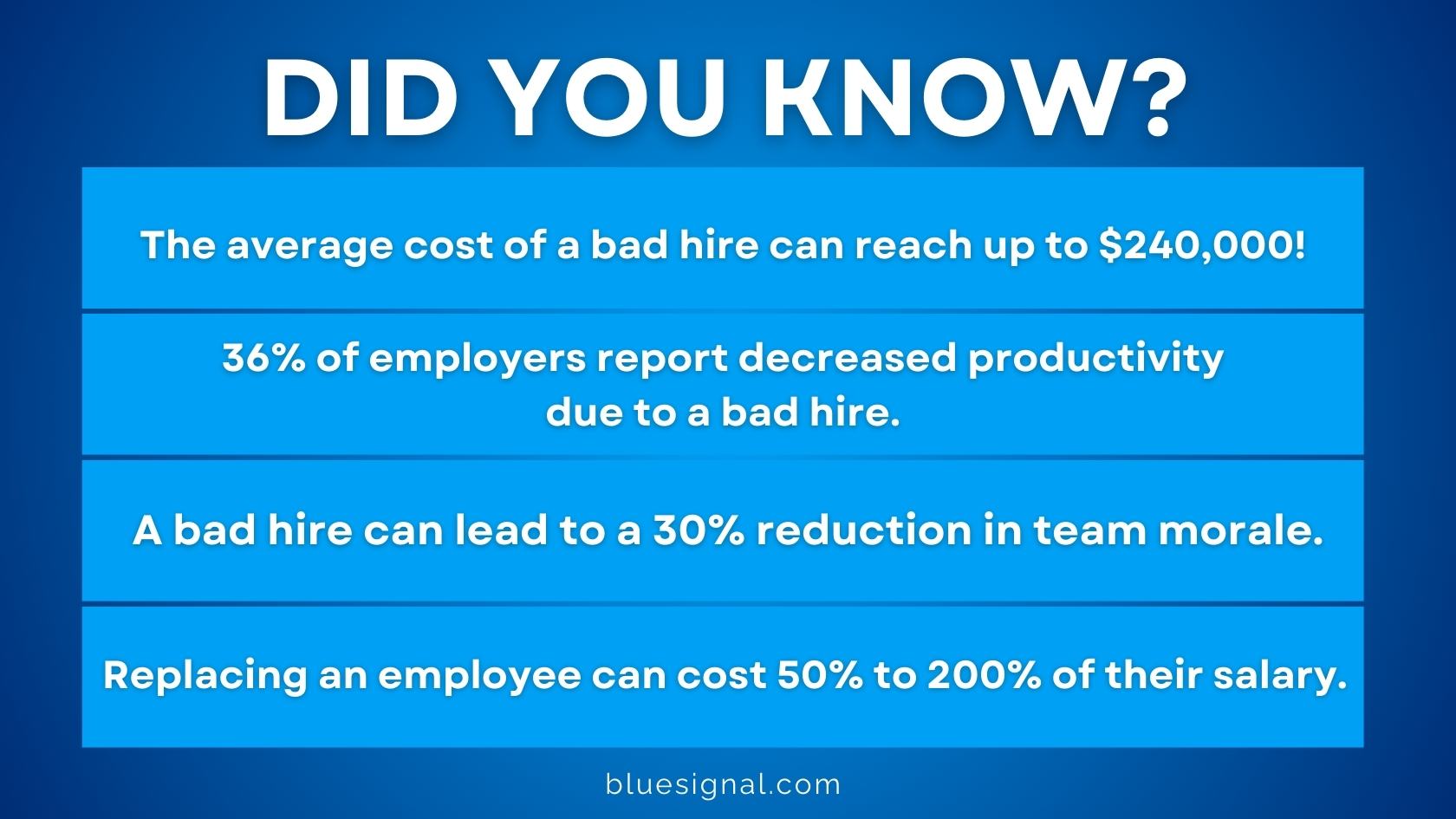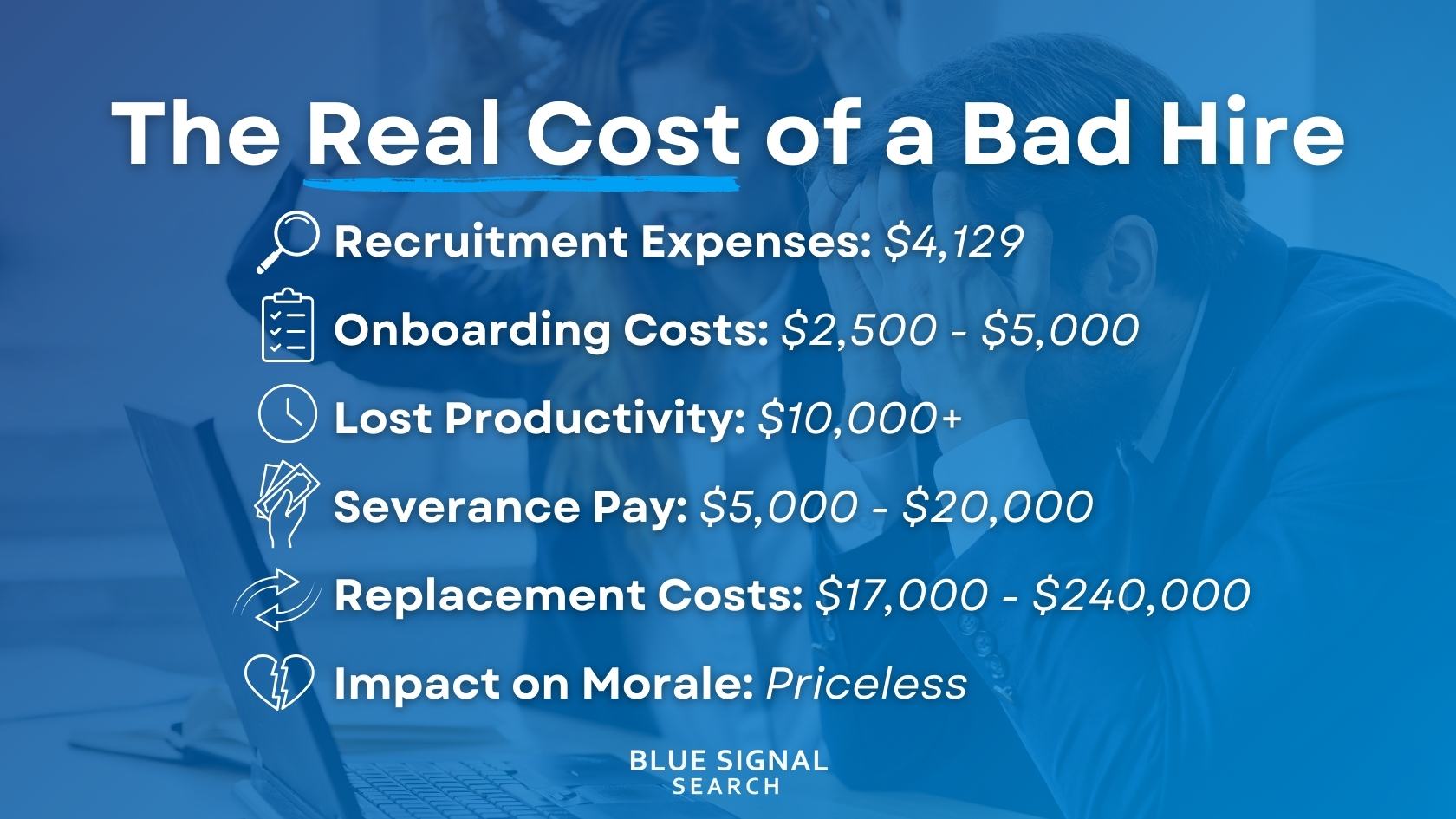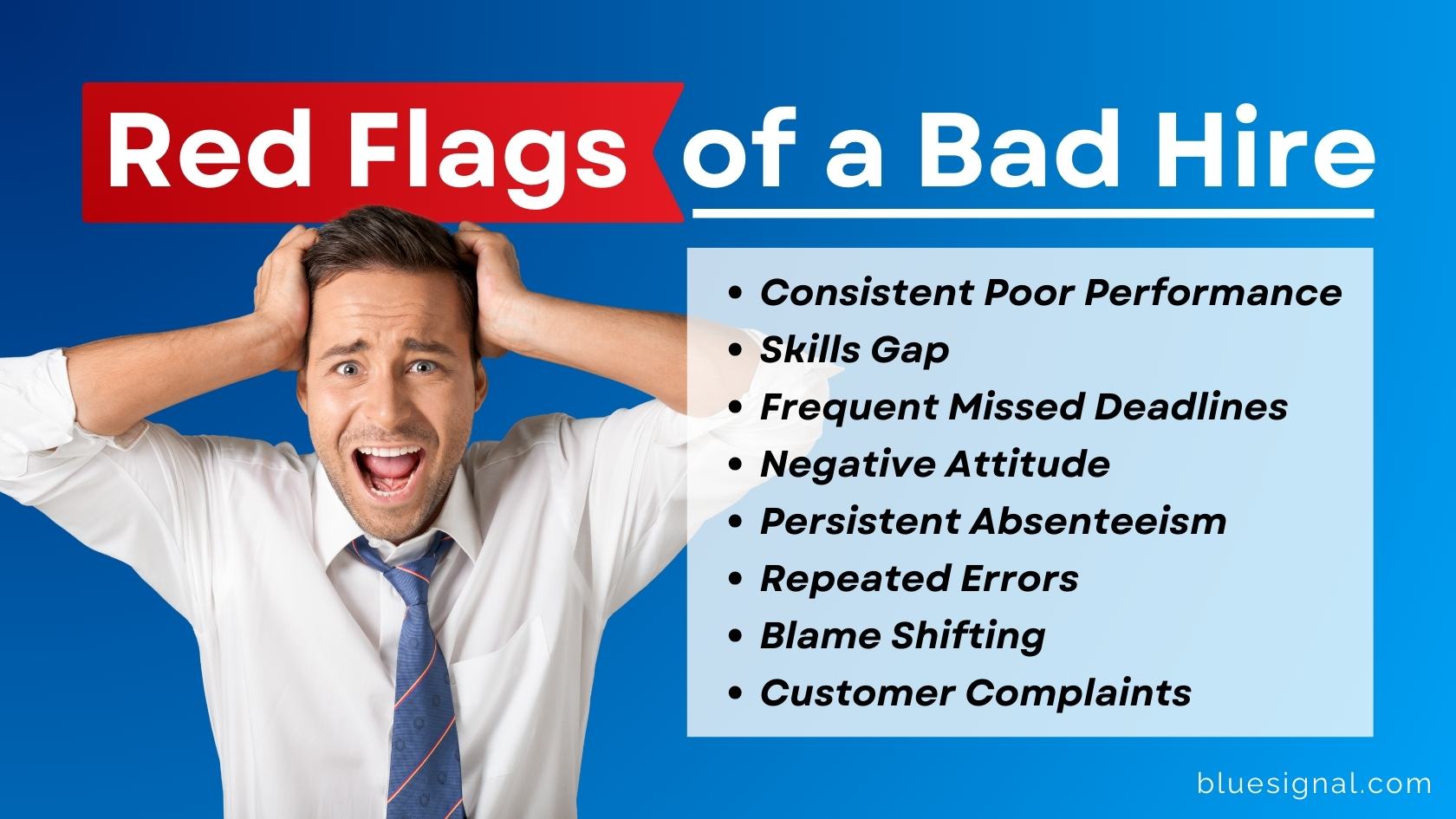Hiring the right people is one of the most critical decisions a business can make. However, when that decision goes wrong, the consequences can be more severe than you might expect. A bad hire doesn’t just drain financial resources—it can disrupt team productivity, damage company culture, and even tarnish your brand’s reputation.
According to a SHRM study, the average cost of a bad hire can reach up to $240,000. This staggering figure includes not just the investment in recruitment and training, but also the less obvious costs, such as lost productivity, diminished team morale, and the potential strain on client relationships. However, the financial burden is only one aspect of the issue.
In this blog, we’ll explore the wide-ranging consequences of a bad hire on your business. We’ll look beyond the financial implications to examine how a poor hiring decision can lead to operational inefficiencies and increased turnover rates. You’ll also learn how to identify the early warning signs of a bad hire and discover practical strategies to prevent these costly mistakes. Additionally, we’ll discuss how partnering with a recruiter can help ensure you make the right hire every time.

Understanding the True Cost of a Bad Hire
Hiring mistakes can be costly, affecting not just your bottom line but also the day-to-day operations and overall health of your business. Here’s a closer look at the wide-ranging impacts of bringing the wrong person on board.
1. Recruitment and Onboarding Expenses
To begin with, the financial burden starts with the hiring process itself. According to the Society for Human Resource Management (SHRM), the average cost-per-hire is about $4,129. This includes expenses related to job postings on platforms like Indeed and LinkedIn, as well as the time HR and management spend on interviews and background checks. However, when the hire doesn’t work out, these costs double as you face severance pay, which can range from a few thousand dollars to several months’ salary, and the expenses of starting the recruitment process all over again. Ultimately, these direct costs can quickly drain resources that could be better allocated to other critical areas of your business.
2. Productivity Losses and Team Disruption
Beyond the initial costs, a bad hire also significantly impacts productivity. In fact, research from CareerBuilder found that 36% of employers reported a decrease in productivity due to a bad hire. When an employee underperforms, other team members often have to pick up the slack, which can lead to increased workloads and higher stress levels. This, in turn, can cause a 39% decrease in employee morale, as found in the same study. Over time, these issues can lead to burnout and higher absenteeism, ultimately slowing down projects and negatively affecting the quality of work, which can have a lasting impact on your business’s performance.
3. Cultural and Moral Implications
Moreover, the impact of a bad hire extends beyond financial costs and productivity losses—it can also deeply affect your company culture. According to the Forbes Human Resources Council, a bad hire can lead to a 30% reduction in team morale, contributing to a toxic work environment. This reduction in morale can result in higher turnover rates, with 29% of companies reporting that a bad hire led to increased turnover among good employees. Furthermore, a bad hire can damage the company’s reputation, both internally and externally, making it harder to attract top talent and retain clients, as negative experiences are often shared on platforms like Glassdoor, Indeed, Google, and others.
4. Long-Term Financial Impact
Finally, it’s important to consider the long-term financial repercussions of a bad hire. According to CareerBuilder, the average cost of hiring the wrong employee is $17,000, while similar research from Northwestern University found that it could be $15,000 on average. For senior roles, these expenses can escalate significantly. The U.S. Small Business Administration estimates that hiring a new worker typically costs between 1.25 to 1.4 times their base salary when factoring in benefits and taxes. Moreover, the onboarding period, which can last from three months to a year, represents a substantial investment before a new hire becomes fully productive. If the employee leaves before this investment is recouped, the financial loss is amplified. Gallup research further emphasizes that replacing a worker can cost between half to twice their salary, underscoring the ongoing financial strain a bad hire can place on your company.

Calculate the Cost of a Bad Hire for Your Business:
As you can see, the costs associated with a bad hire can accumulate quickly, affecting both the financial health and overall stability of your business. But how can you quantify these impacts? To help you assess the true cost of a bad hire, we’ve developed a simple yet powerful formula. This formula allows you to plug in your specific numbers and get a clearer picture of what a bad hire could mean for your business.
Formula Breakdown:
- Hiring Costs = Recruitment Expenses + Job Ads + Background Checks
- Onboarding Costs = Training Expenses + Orientation + Resources Provided
- Compensation = (Salary + Benefits) x Duration of Employment
- Lost Productivity = (Expected Productivity - Actual Productivity) + Time Spent by Others
- Team Impact = (Cost of Decreased Morale + Potential Turnover Costs)
- Exit Costs = Severance Pay + Legal Fees + New Recruitment Costs
Hiring Costs + Onboarding Costs + Compensation
+ Lost Productivity + Team Impact + Exit Costs
= Total Cost of a Bad Hire
This formula helps highlight the significant financial impact a bad hire can have. By using this calculation, you can gain a deeper understanding of the importance of making informed hiring decisions to protect your business from unnecessary costs. Want to see how this applies to your business? Try our cost of a bad hire calculator below to calculate your potential costs instantly.
Cost of a Bad Hire
How to Identify a Bad Hire
Given these potential financial impacts, it's crucial to recognize a bad hire early to minimize long-term damage. Every new hire represents a fresh opportunity to strengthen your team, but occasionally, even the most promising candidates don’t work out as expected. Recognizing when a new employee isn’t fitting in is crucial to maintaining your company’s momentum. It’s important to remember that everyone has an adjustment period, so one or two hiccups early on don’t necessarily spell trouble. However, when issues persist despite support and time, they may signal a deeper problem. It’s essential to consider the broader context—look at the full picture, including how the employee is affecting team dynamics, meeting performance expectations, and aligning with your company culture. By staying attentive to these elements, you can spot potential problems before they start to drag down your business. Here are some red flags that might indicate you’ve made a bad hire.

Red Flags of a Bad Hire:
- Consistently poor performance, even after sufficient training and onboarding.
- A skills gap between what was promised during the interview and what’s delivered on the job.
- Frequently missed deadlines or failure to meet key performance indicators (KPIs).
- A negative attitude that disrupts team harmony or clashes with company values.
- Persistent lateness or absenteeism without a reasonable explanation.
- Repeated errors or the same mistakes made over and over, despite feedback.
- A tendency to blame others for mistakes or failures rather than taking responsibility.
- Customer complaints or negative feedback linked to the employee’s work.
Addressing these red flags early can help prevent more significant problems down the line. It’s not just about identifying issues but understanding whether they’re temporary or indicative of a poor fit. Sometimes, problems can be resolved with additional training or adjustments to the role. However, if the issues persist despite your best efforts, it might be time to reevaluate the hire. By considering the context and taking thoughtful action, you can protect your team’s productivity and morale. Up next, we’ll dive into strategies to avoid these costly hiring mistakes in the first place, helping you build a stronger, more resilient team.
Leverage Recruiting Experts to Avoid Costly Mistakes
Sometimes, even with the best processes in place, finding the right candidate can be challenging. This is where partnering with a recruiter can make a significant difference. Recruiters bring a wealth of expertise and resources that can help you avoid the pitfalls of a bad hire. They have access to a broader talent pool and can quickly identify candidates who not only meet the technical requirements but also fit your company culture. Recruiters can streamline the hiring process by pre-screening candidates, conducting thorough interviews, and even performing reference checks on your behalf. This expertise reduces the likelihood of a bad hire and the associated costs, freeing you up to focus on other critical aspects of your business.
Why Partner with Blue Signal Search?
At Blue Signal Search, we go beyond traditional recruitment by offering tailored solutions that align with your company’s unique needs. With over 2,700 successful placements and a 94% retention rate, we specialize in connecting top-tier talent with businesses across various industries. Our deep market understanding allows us to not only find the right candidates but also provide insights into industry trends and competitive compensation packages, ensuring you attract and retain top performers. We’re committed to supporting you throughout the entire hiring process, making sure that every placement contributes to your long-term success. Partnering with Blue Signal Search means investing in a strong, cohesive team that drives your business forward while helping you avoid the costly repercussions of a bad hire.
Protect Your Business from the Costs of a Bad Hire
As we’ve explored, the cost of a bad hire goes far beyond financial loss—it can disrupt team dynamics, damage company culture, and slow down your business’s growth. To avoid these pitfalls, it’s essential to take proactive steps throughout the hiring process. This includes crafting clear job descriptions, implementing structured interviews, assessing cultural fit, and using practical evaluations. These strategies are key to ensuring you bring the right talent into your organization.
Even with the best practices in place, hiring can still be a complex and time-consuming task. That’s where our recruiting services come in. With our expertise and access to a broad talent pool, we can help you navigate these challenges and secure the right candidates who will thrive in your company. Ready to protect your business from the hidden costs of a bad hire? Fill out the form below, and let’s work together to strengthen your team.
Partner with us for your next hire.
Set up a free consultation with a recruiting manager. Tell us about your hiring need.
By submitting this form, you consent to receive communications from Blue Signal via phone, email, and conversational SMS. Message frequency varies. Msg & data rates may apply. Reply STOP to opt out or HELP for assistance. Visit Privacy Policy and Terms of Service.
